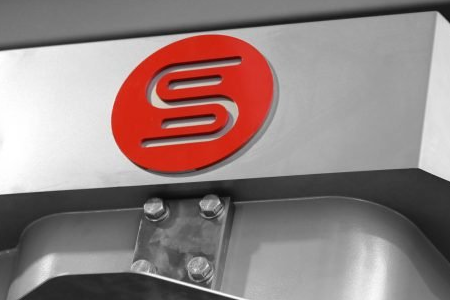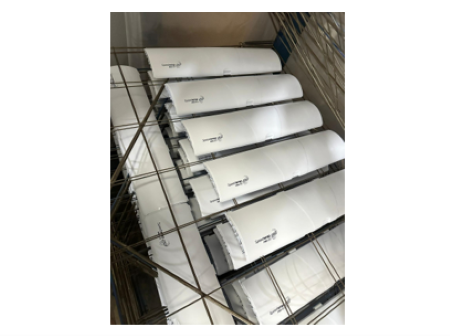International Bakery magazine investigates the challenges in commercial mixing and depositing and what advancements have improved sanitation, maintenance and digital solutions.
Mixing systems in the bakery industry should obtain a high degree of mixing quality within the shortest time. Sophisticated mixing operations can be carried out regarding products of greatly differing properties such as density, granulation and consistency in highly sensitive production areas. Key to this, is fulfilling the highest requirements when it comes to hygienic design with minimal product residue and optimised cleaning features. Cleaning features include a fast and easy cleaning access to the mixing chamber and mixing tools as well as a complete CIP (cleaning in place) cleaning system.
“Our blenders are executed in food grade, comply with FDA regulations, and meet explosion prevention regulations like ATEX, NFPA etc. They also guarantee adherence to quality guidelines like HACCP and IFS standards,” a spokesperson from Daxner says.
Vertical ribbon blenders deliver a high mixing accuracy within a very short time. Sophisticated mixing operations can be carried out for products with many different characteristics (densities, granulation, heat sensitive, pressure sensitive and hydroscopic).
“The material enters the mixing chamber through a suitably-sized inlet and is simultaneously distributed by the mixing tool. The mixer shaft is suspended and supported from the drive shaft. The mixing action is – product is transported up the wall of the mixer then cascaded down the centre. The complete content is kept in constant motion, there are no dead zones. Even with batches as low as approx. 10% of the capacity, an optimal mixing quality is still achieved,” they explain.
The variable speed drive allows for gentle mixing. The use of the high-speed cutter rotors enables high intensity mixing and to add inclusions such as liquids, flakes or block fats.
The system is designed with a large inspection door for necessary inspections, easy cleaning by hand, automatic cleaning in place (CIP) and disinfection. The inside of the mixer is covered with a non-stick coating. Additional sockets for venting, inspection hatch and additional intake positions are considered during the design process. The mixer is discharged at the bottom by means of a rotating arm which covers the complete bottom of the mixer, and direct the product to the outlet port.
“As an investment in the company’s future, the baking ingredient manufacturer set its eye on expanding its existing capacity and ensuring its technological advantage. Daxner convinced with an innovative, sustainable solution: A multi-purpose system with three separate mixing lines. For two years now, it has proven itself to the customer’s complete satisfaction.
“With the multi-purpose system Daxner developed a complete solution that ensures top-quality products along with great production flexibility and economy. Based on a CAD system design, about 2,000 hours of planning resulted in a system that automates the entire production process, including storage and discharging, dosing and weighing, feeding and mixing, all the way to packaging. Due to the comprehensiveness of the task, and the dimensions of the project, the development process involved specialists from other fields from the very beginning. These included control and electrical technology, steel construction and mixing and filling technology.”
Meeting the highest demands
It incorporates not only product safety, but also traceability of raw materials and batches — plus, it is very easy to clean. Equally important to its performance are gentle material and product handling with pneumatic conveyor technology, conditioned conveyor air, and the technology used for the mixing process. High-precision mixing and simultaneously gentle product handling are achieved with the vertical two-shaft mixer. The plant complies to the highest standards, such as ISO-9000, HAACP and IFS.
One system, a multitude of products
As a multi-purpose system, it consists of three mixing lines that allow a single production system to produce a wide range of products, such as convenience mixes, fine baked goods and fillings.
This poses another challenge in the wide diversity of raw materials used: From very sticky to shooting, heavily fluidising bulk materials, there is a wide range of varied characteristics that complicate handling.
From raw materials to finished baking ingredients
The raw materials for the final products are stored in external silos. Pneumatic conveying brings a wide array of components into the day silos, including wheat meal, spelt flour, rye meal and granulated sugar. All silos and all containers have weighing equipment that continuously monitors the filling level. The 32 silos have capacities up to 12 m3 and can also be manually loaded with bags by a total of three bag dump stations with control screens. Vibro bin dischargers handle the discharge of the products. Dosing screw conveyors move the product to the weighing bin. For both high-volume and very precise dosing, separate coarse and fine dosing screws are used.
The weighing of raw materials takes place in weighing bins, from where the product is brought to the respective, preliminary mixing bin of the three separate 2,500-litre batch mixers. In front of each batch mixer there is a bag intake station with weighing equipment to feed minor bagged ingredients. After successful mixing, the finished products reach the post mixing bins. For fatty baking ingredients, rotary bin dischargers are used. The finished products are stored in an automatic pallet storage and retrieval system.
Sophisticated quality assurance
All raw materials pass a control screen and are also checked for metallic impurities. The finished products even undergo double inspection: Metal detectors find and remove all foreign metal objects. Moreover, the system uses an X-ray device that is an innovation in the foods industry: Before the baking ingredients leave production, they are X-rayed, so that all foreign objects can be reliably seen and removed.
Cleanliness through a central dust extraction system
Another intelligent detail is the central dust extraction system that has proven itself with distinction. A pipe system provides a connection to each production station. Product residues are extracted by a cyclone filter. The dust extraction system is designed for simultaneous operation of six extraction points with 2-level vacuum pumps.
Blending
All small and medium components are solely pre-commissioned in the corresponding allergen rooms. These rooms are physically separated from each other in terms of the handled allergen and therefore they only permit access with hygienic, protective clothing. Subsequently a forklift truck positions the bags and the pre-commissioned small and medium ingredients onto the operating platform. There, the operator fills the ingredients into one of the two existing VIB & PRESS bag intake stations.
Depending on the product characteristics the mixing system itself is specifically selected. Line one is equipped with a horizontal paddle mixer and line two with a horizontal ploughshare mixer, in order to provide highest flexibility for various mixing jobs.
The control screening machine operates according to the principle VIB and PRESS – an innovation from Daxner. In doing so, it encompasses two major processes: The vibrating screen sieves the product (VIB) and simultaneously slowly rotating paddles press the product through the flat screen (PRESS), in order to gently dissolve agglomerations and lumps. Even if small mesh widths are used, the screen remains free of any residues and at the same time it enables its cleaning due to its vibrations. The drive is provided by a geared motor with variable speed through frequency converters. The tilt-up mechanism of the entire top part ensures quick cleaning. Also, the implementation of a permanent magnet grid is possible for the elimination of magnetic contaminations. This system screens products with poor flow characteristics respective products which tend to clump or with high fat content by incorporating small mesh widths and reasonable throughput.
The mixer is designed according to the EHEDG- standards with two large cleaning doors. The mixing system enables a high mixing accuracy (higher 1:100.000) and short mixing times ranging from 1 to 5 minutes. Also, extremely different ingredients (bulk density, particle sizes and structure) can be added to the mixing process.
Bag filling
The finished mixes are discharged into the corresponding mixer receiver bin, which holds the entire mixing capacity. Receiver bins are in hygienic design and equipped with a vibro discharger – in combination with a pressurised air cleaning in the discharge cones – which ensures their residue free discharge. The implementation of the mixer receiver bins enables a fast discharge of the mixers and additionally provides a buffer volume for the below positioned bag filling station. Therefore, the number of batches and consequently the plant performance is notably increased.
Below the mixer receiver bin the finished mixes are filled into packages ranging from 15 kg to 25 kg by using a bag filling and weighing system, called DAX-PVS. This completely gravimetric and compact designed bag filling station combines a simple, semi-automatic handling with high throughput and easy cleaning (no residue!). The innovation of the bag filling system is the so called PVS dosing system (Pinch Valve System), consisting of a pneumatically actuated rubber hose-dosing system. One major advantage is the easy cleaning of the inner surface of the hose, which is in contact with the product. The hose of the pinch valve system was developed with a very smooth inner surface, in order to achieve high dosing accuracy and discharge of the residue. Once the filling of the bags is completed, they are dust tightly sealed, placed on a conveyor belt und subsequently quality controlled by a tunnel metal detector. Finally, the bags are transported to palletising.
Terry Bartsch – Product Group Leader, Dough Systems, AMF Bakery Systems says: “AMF offers a wide range of mixing and dough handling solutions to process dough batches ranging from 100lb to 3200lbs of dough. Mixers are available with either triple roller bar or sigma arm agitators suitable for a wide range of doughs from soft bread and buns, artisan bread and rolls, pizza and flatbreads, and a variety of stiff doughs and specialty snacks. Seamless integration of AMF’s complete dough handling systems ensures labour-free dough handling from mixer to make-up system including fermentation rooms, dough troughs, trough hoists, dough chunkers and incline conveyors as well as raw dough conveyors.”
Reducing waste
Reducing waste is also a key concern for bakers and AMF Tromp’s exact depositing, targeted strewing and waterfall application of decoration materials makes it possible to ensure greater accuracy while reducing waste during production. Targeted strewing of decoration materials allows for depositing accurately on top of the product significantly reducing waste. The AMF Tromp Target Applicator prevents spilling and the ability to adjust applications by ingredient adds to production cost savings.
“Using waterfall decoration enables high-speed decoration strewing for any cake or snack cake line. AMF Tromp’s Waterfall Applicator integrates into existing lines and uses recirculation of ingredients to strew and decorate more sustainably reducing product waste,” says Bartsch.
AMF’s Direct Open Frame Mixer (DOFM) and APEX Direct Drive Mixer (DDM) are both suitable horizontal batch mixers for mixing doughs ranging from 100lb to 1000lb of dough. For the greatest product flexibility, the AMF mixers offer either triple roller bar or sigma arm blade agitator options for mixing a wide range of dough from bread, buns, English muffins, flour or corn tortillas, to cookies, crackers, biscuits, pie doughs, and a variety of specialty snacks. The open frame, stainless steel design allows for easy access sanitation and maintenance and is designed with the most robust frame and bowl design in the industry. Both mixers utilise an innovative bowl tilt system to eliminate the need for hydraulic chains or belt tilt components for maintenance-free operation.
“The Unimac Depositor by AMF Tromp is a universal electronic depositor with interchangeable depositing heads suitable for a wide range of cookies, batters, meringues, eclairs, gluten-free breads, choux-paste and many more types of products. The modular, compact design allows smaller bakeries to easily grow their depositing system for greater sophistication and automation. AMF’s Unimac Depositor provides multiple tooling options and extensive programming possibilities allowing you to quickly change between two depositing heads for simple product changeover. The Depositor processes three to seven pans per minute using standard 18×26 sheet pans,” he says.
To stay up to date on the latest, trends, innovations, people news and company updates within the global bakery market please register to receive our newsletter here.
Media contact
Roshini Bains
Editor, International Bakery
Tel: +44 (0) 1622 823 922
Email: editor@in-bakery.com







